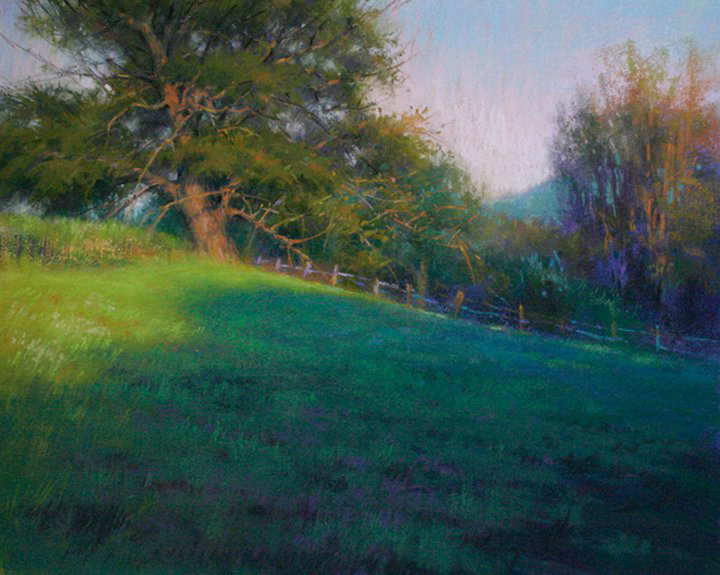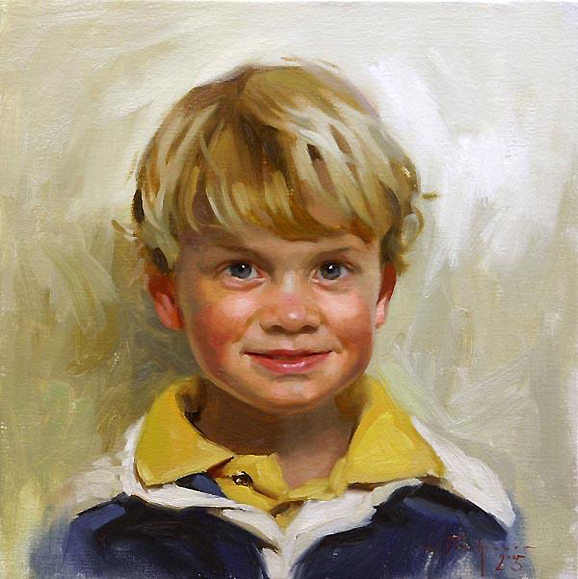
What are cool and warm colors? To understand the theory of cool and warm colors visit this page that I found. Very interesting! But take a good look at this beautiful pastel painting by Lisa Mitchell and you understand the cool-warm contrast immediately. (We painters need images, not words, at least I do.) The shadows are cool in this painting and the light areas are warm.
General rule of thumb: warm light – cool shadow or cool light – warm shadow
Usually in portraits with indoor lighting you see the cool light-warm shadow contrast. To simplify: Light is cool, shadows are warm, deep shadows are hot. In my portrait commissions I don´t want to exaggerate the warm-cool counterposition but in the lightest flesh tones I almost always use this contrast.
In the portrait below I use a crimson-white mix for the highlights on the cheeks and nose tip and a veridian green-white mix for the highlight on the bridge of the nose. Both cool tones.

Thankyou for taking the time to talk about warm/cool colours Ben ! Its very uselfull for us self taught painters. I bought your first video and you are so adept now at painting and going through the process in your head that you complete it usually in one sitting ala prima. It would be interesting to know what techniques and thought processes you have when you start work on a painting which has already partially dried. Do you glaze alot? Also, you talk about mediums on your blog, but how do you add the medium? how do you gauge how much to use? Do you use a pipette or something or just dip your palette knife into the bottle?
Thanks,
Earl
Hi Earl.
I really must apologize for answering so late. Shame on me! Maintaining this blog is a challenge but I must have overlooked your questions. Yes, I complete the painting of the face in one day. That is crucial to me. I find it hard to come back the next day when some parts already are half dry. About medium. If you know you will run out of time in the first session you can have a try with a retarding medium. Once I tried clove oil. I added one single drop to each heap of paint by using a pipet before starting. Paint won´t dry for days and days. But it is tricky. There is no much information on the sustainability of the painting over the years. I avoid glazing. I prefer the alla-prima approach because of the fresh power of the colours. In general I try to keep painting without any medium as long as I can. But when the canvas is very dry, I might rub the surface with a netral drying medium just before starting.
Best. Ben
Thankyou for taking the time to talk about warm/cool colours Ben ! Its very uselfull for us self taught painters. I bought your first video and you are so adept now at painting and going through the process in your head that you complete it usually in one sitting ala prima. It would be interesting to know what techniques and thought processes you have when you start work on a painting which has already partially dried. Do you glaze alot? Also, you talk about mediums on your blog, but how do you add the medium? how do you gauge how much to use? Do you use a pipette or something or just dip your palette knife into the bottle?
Thanks,
Earl
Hi Earl.
I really must apologize for answering so late. Shame on me! Maintaining this blog is a challenge but I must have overlooked your questions. Yes, I complete the painting of the face in one day. That is crucial to me. I find it hard to come back the next day when some parts already are half dry. About medium. If you know you will run out of time in the first session you can have a try with a retarding medium. Once I tried clove oil. I added one single drop to each heap of paint by using a pipet before starting. Paint won´t dry for days and days. But it is tricky. There is no much information on the sustainability of the painting over the years. I avoid glazing. I prefer the alla-prima approach because of the fresh power of the colours. In general I try to keep painting without any medium as long as I can. But when the canvas is very dry, I might rub the surface with a netral drying medium just before starting.
Best. Ben